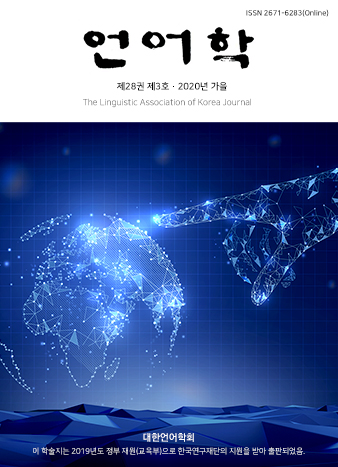대한언어학회 전자저널

28권 3호 (2020년 10월)
- 증거성 표지의 통사적 투사
-
심창용
Pages : 1-15
Abstract
Sim, Chang-Yong. (2020). Syntactic representation of evidentiality markers. The Linguistic Association of Korea Journal, 28(3), 1-15. Languages like Korean employ evidentiality markers such as Inference kyess-, Sensory -ney/-te-, Reportative -ay, and Quotative ko. These evidentiality markers receive interpretations outside the scope of negation and certain adverbs are associated with a particular evidential marker. In addition, certain evidentiality markers co-occur while other evidential markers exhibit a co-occurrence restriction. In order account for these facts, the current paper proposes a slightly complicated but fine structure of C area with evidentiality markers. Each evidentiality marker occurs on the relevant functional head in the C domain. By positing this fine structure of CP, the facts that evidentiality is out of the scope of negation and the choice of certain adverbs as well as the selectional restrictions between the functional heads can be accounted for.
Keywords
# 증거성(evidentiality) # 증거성 표지 (evidentiality marker) # 통사 구조(syntactic structure) # 다층위 CP(layered CP)
References
- Aikhenvald, A. Y.(2004). Evidentiality. Oxford: Oxford University Press.
- Baek, J. Y. (1998). Negation and object shift in early child Korean. In U. Sauerland & O. Percus (Eds.), The interpretive tract (MITWPL 25)(pp. 177-204), Cambridge, MA: MIT Press.
- Bhadra, D. (2017) Evidentiality and questions: Bangla at the interface. Unpublished doctoral dissertation. Rutgers, The State Univ. of New Jersey.
- Bhadra, D. (2018). Evidentials are syntax-sensitive: The view from Bangla. Glossa: A Journal of General Linguistics, 3(1), 106. DOI: https://doi.org/10.5334/gjgl.449
- Bybee, J., Perkins, R., & Pagliuca, W. (1994). The evolution of grammar: Tense, aspect and modality in the languages of the world. Chicago: University of Chicago Press.
- Chafe, W. (1986). Evidentiality in English conversation and academic writing. In W. Chafe and J. Nichols (Eds.), Evidentiality: The linguistic coding of epistemology (pp. 261–272). Norwood, NJ: Ablex Publishing Corporation.
- Cheng, L. (1991). On the typology of wh-questions. Unpublished doctoral dissertation, MIT.
- Chomsky, N. (1995). The minimalist program. Cambridge, MA.: The MIT Press
- Chung, K. (2005). Space in tense: The interaction of tense, aspect, evidentiality and speech act in Korean. Unpublished doctoral Dissertation. Simon Fraser University.
- Chung, K. (2010). Korean evidentials and assertion. Lingua, 120, 932-955.
- Cinque, G. (1999). Adverbs and functional heads: A cross-linguistic perspective. Oxford: Oxford University Press.
- De Haan, F. (1999). Evidentiality and epistemic modality: Setting the boundaries. Southwest Journal of Linguistics, 18, 83-101.
- Demonte, V., & Fernández-Soriano, O. (2014). Evidentiality and illocutionary force: Spanish matrix que at the syntax-pragmatics interface. In A. Dufter & A. O. de Toledo (Eds), Left sentence peripheries in Spanish: Diachronic, variationist, and typological perspectives. [Linguistics Today Series] (pp. 217-252). Amsterdam: John Benjamins
- Faller, M. (2002). Semantics and pragmatics of evidentials in Cuzco Quechua. Doctoral Dissertation. Stanford University. http://ling.man.ac.uk/info/staff/MTF/publications.htm
- Hagstrom, P. (2002). Implications of child error for the syntax of negation in Korean. Journal of East Asian Linguistics, 11, 211-242.
- Izvorski, R. (1997). The present perfect as an epistemic modal. In A. Lawson (Ed.), Semantics & linguistic theory (SALT) VII (pp. 222-239), Ithaca, NY: Cornell University.
- Jespersen, O. (1924). The philosophy of rammar. George Allen & Unwin Ltd.
- Kim, J. (2012). Korean evidentials in discourse. Unpublished doctoral Dissertation, University of Texas at Austin.
- Kim, J-B. (2000). On the prefixhood and scope of short form negation. Harvard Studies in Korean Linguistics, 8, 403-418.
- Kim, N. (2000). Reportative evidential in Korean. Journal of the International Circle of Korean Linguistics, 10, 105-124.
- Kim, M. Shin (2006). Evidential strategies in Korean conversations: An analysis of interactional and conversational narrative functions. Unpublished doctoral dissertation. University of Hawaii.
- Lim, D. (2010). Evidentials and interrogatives: A case study from Korean. Unpublished doctoral Dissertation, University of Southern California.
- Lyons, J. (1977). Semantics 2. Cambridge Univ. Press
- May, R. (1985). Logical form. Cambridge, Mass.: MIT Press.
- Palmer, F. R. (2001). Mood and modality (2nd ed.), Cambridge: CUP.
- Rizzi, L. (1997). The fine structure of the left periphery. In L. Haegeman (Ed.) Elements of grammar: A handbook of generative syntax (pp. 281–337). Dordrecht: Kluwer.
- Simeonova, V., & Zareikar, G. (2015). The syntax of evidentials in Azeri, Bulgarian, and Persian. Proceedings of the 2015 annual conference of the Canadian Linguistic Association.
- Sohn, H. (2018). Evidentiality in Korean. In A. Y. Aikhenvald (Ed.) The Oxford handbook of evidentiality. Oxford: Oxford University Press. DOI: 10.1093/oxfordhb/9780198759515.013.33
- Song, S-C. (1982). On interpreting the scope of negation in Korean. Language Research, 18(1), 197-215.
- Speas, M. (2004). Evidentiality, logophoricity and the syntactic representation of pragmatic features. Lingua, 114, 255-276.
- Speas, P. (2008). On the syntax and semantics of evidentials. Language and Linguistics Compass 2, 940-965.
- Speas, P., & Tenny, C. (2003). Configurational properties of point of view roles. In A. M. Di Sciullo (Ed.), Asymmetry in grammar, 1 (pp. 315–345). Amsterdam/Philadelphia: John Benjamins. DOI: https://doi.org/10.1075/la.57.15spe
- Suh, J-H. (1989). Scope interaction in negation. Harvard Studies in Korean Linguistics, 3, 527–536.
- Suh, J-H. (1990). Scope phenomena and aspects of Korean syntax. Unpublished doctoral dissertation, University of Southern California.
- Tenny, C. (2006). Evidentiality, experiencers, and the syntax of sentence. Journal of East Asian Linguistics, 15, 245–288.
- Walker, C. (2016). Identifying pragmatic uses of evidentials in Korean discourse: Observations from native and non-native speaker data. Language Facts and Perspectives, 37, 91-116.
- Walker, C. (2019). L1 and L2 Korean evidential use: Using the discourse completion task (DCT). Language Facts and Perspectives, 46, 31-55.
- Willett, T. (1988), A cross-linguistic survey of the grammaticization of evidentiality. Studies in Language, 12, 51-97.
- 김진웅. (2012). 한국어 증거성의 체계. 한국어 의미학, 39, 101-124;
- 송재목. (2009). 한국어 증거성표지의 중복실현과 통사영역. 한국언어학회 학술대회지, 221-228.
- 송재목. (2011). 한국어 증거성표지의 중복실현. 비교문화연구, 22, 355-375.
- 송재목. (2018). 한국어의 어휘적 증거성. 언어학, 82, 105-131.